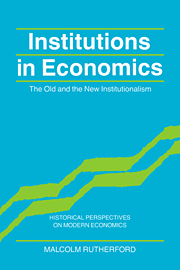7 - Conflicts and complementarities
Published online by Cambridge University Press: 12 January 2010
Summary
The preceding chapters have dealt in detail with those standard dichotomies that have been an integral part of the official rhetoric of both the OIE and the NIE. That such a sharp division between the two traditions should be so ingrained is not surprising. The OIE has frequently expressed outright opposition to more orthodox programs, anything less being seen as an undesirable lack of “paradigm discipline” (Stanfield 1989). Similarly, the NIE is associated with such negative views of the old that it would be impossible for anyone to admit to a serious interest in the old without casting doubt on their own theoretical credentials.
In many ways, this extreme distancing of the two traditions is not helpful. Each faces a common set of problems, and each can learn from the other. This is not to suggest that the old and the new institutionalisms are the same or can simply be stuck together in a single program. Indeed, the old and the new both contain more than one identifiable research program. Nevertheless, these various programs attempt to deal with many of the same issues and contain points of contact and areas of complementarity. Furthermore, an appraisal of the strengths and weaknesses of these programs leads to an understanding of the underlying difficulties that any attempt to develop an institutional economics must face, and points to those directions that might be taken in the pursuit of a more satisfactory program of research than either the old or the new currently provides.
- Type
- Chapter
- Information
- Institutions in EconomicsThe Old and the New Institutionalism, pp. 173 - 181Publisher: Cambridge University PressPrint publication year: 1994

